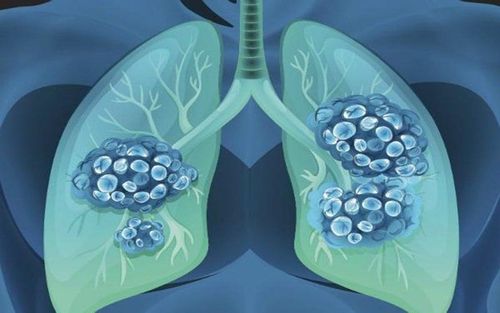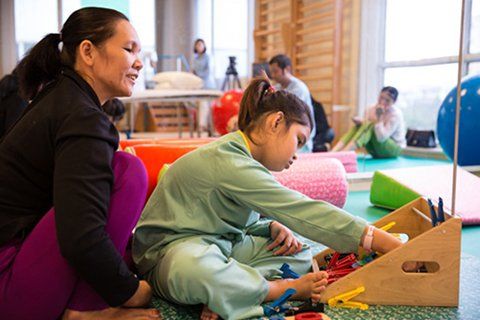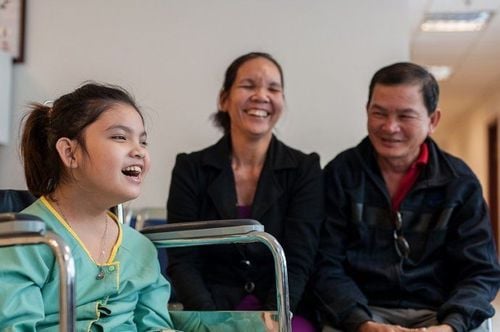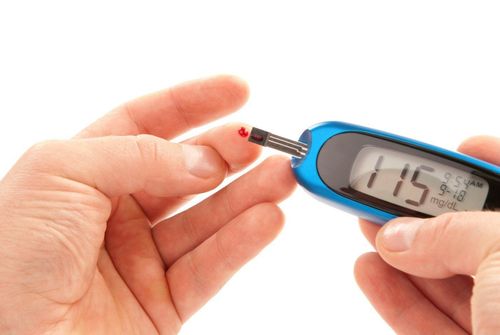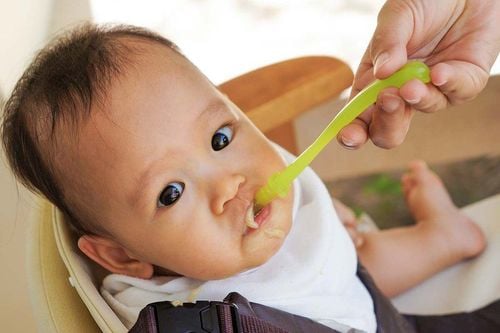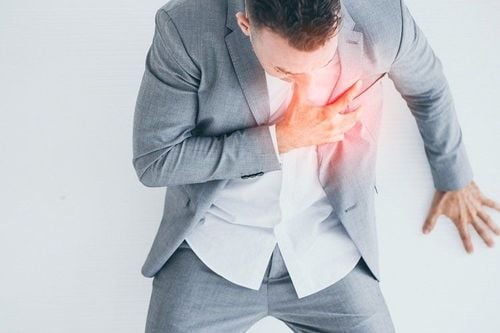This is an automatically translated article.
The article is written by Master, Doctor Vu Duy Chinh - High-tech Unit for Treatment of Cerebral Palsy and Autism - Vinmec Times City International Hospital70 - 80% of patients after stem cell transplant for cerebral palsy have improved motor function, significantly reduced muscle tone, enhanced muscle strength, better coordination in activities, increased appetite mouth and weight gain, improved concentration skills, better memory...
![[Infographic] Quy trình Ghép tế bào gốc chữa bại não](/static/uploads/large_20220128_071807_875151_220125_QT_ghep_TBG_max_1800x1800_jpg_eb4cf3eacb.jpg)
Stem cell transplant to treat cerebral palsy
Stem cell therapy is a very new method of treating cerebral palsy in the world. Stem cells are extracted from bone marrow in a completely sterile environment and infused into the patient's body through the lumbar spine, at the level of L4-5. Stem cells will follow the circulation of cerebrospinal fluid to the brain. Here, stem cells help to proliferate blood vessels, form substances with anti-inflammatory functions, and at the same time stimulate neural stem cells in the area of differentiation and proliferation. Stem cells transplanted into the body also have better neurotransmitter effects. From there, it effectively restores the damaged brain area.
Prof. Dr. Nguyen Thanh Liem, Director of Vinmec Institute of Stem Cell Research and Gene Technology, is the person who directly researched and successfully applied stem cells in the treatment of cerebral palsy in Vietnam. Depending on the type of cerebral palsy, 70-80% of patients after transplantation have improved motor function, significantly reduced muscle tone, increased muscle strength, better coordination in activities, increased sensitivity. appetite and weight gain, improved concentration skills, better memory.
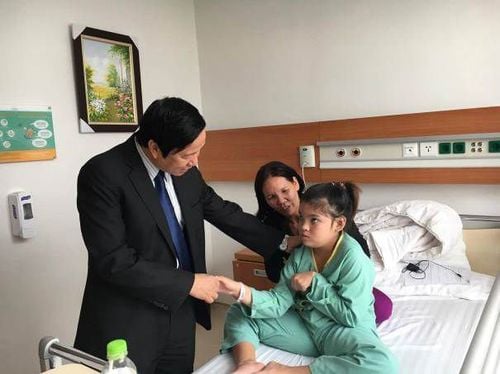
Cerebral palsy stem cell transplant
1. Designation
Supportive stem cell transplantation in the treatment of cerebral palsy is indicated for patients who meet the following criteria
Patients with confirmed diagnosis of cerebral palsy due to acquired causes According to the GMFCS classification of severity grade II to V on cranial magnetic resonance imaging (MRI) with brain lesions consistent with the cause of cerebral palsy Patient has no progressive neurological, genetic, or infectious disease Chromosomes, infectious diseases, coagulation disorders, abnormalities of blood-forming organs, allergies to antibiotics, anesthetics... Pre-transplant pre-transplant examinations and tests of the subjects ensure conditions health perform stem cell transplant treatment
2. Examination and evaluation of patients before stem cell transplantation
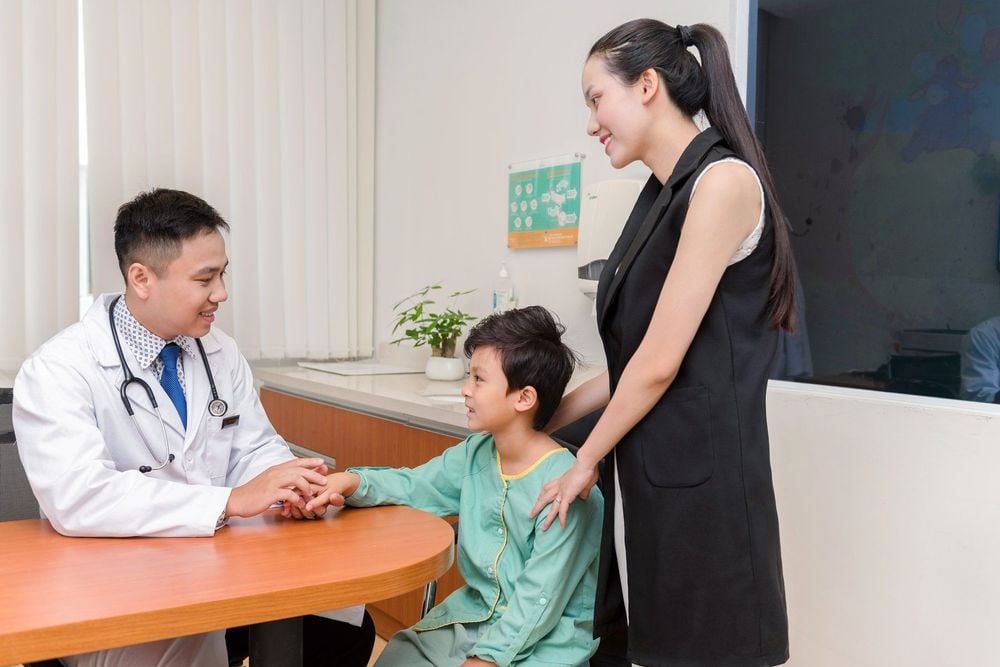
2.1. Ask the sick
The doctor exploits the obstetric history, the developments around the birth, the birth weight, the unusual events arising during the child's development.
2.2. Clinical examination
General examination: Assess weight, height, and mental well-being of children Musculoskeletal: Muscle tone, muscle strength, tendon reflexes... Neurological examination Cardiac and lung examination Assess gross motor function and motor level classification: using the GMFM scale and the GMFCS grading scale Assessment of fine motor function: FMS scale Assessment of muscle tone: improved Ashworth scale Assessment of language, communication and cognitive abilities : Test Denver II.
2.3. Paraclinical examinations
Cranial MRI (with/without anesthesia)Clinically diagnosed patients with acquired cerebral palsy are subjected to a brain MRI scan to assess lesions, some common lesions on the brain. MRI scans of the brain due to acquired causes, including cortical gray matter lesions: Parenchymal atrophy... Subcortical white matter lesions: Periventricular palsy... Cerebral nuclei lesions. ..
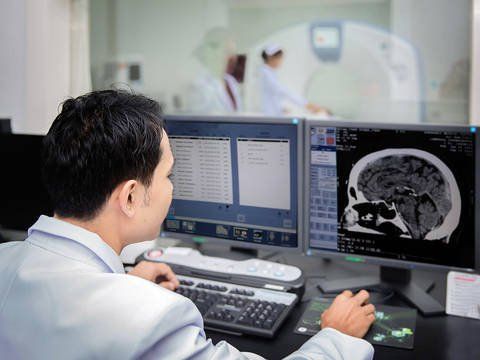
Conduct EEG measurement to assess the patient's risk and seizure status before transplantation Electrocardiogram
Conduct electrocardiogram to assess the child's general health before stem cell transplant , ensure safety during anesthesia, bone marrow and stem cell transplantation Cardiopulmonary X-ray
Cardiopulmonary x-ray supports clinical examination and assessment of respiratory status of study participants ensure health during stem cell transplantation Blood biochemistry test
Liver function: GOT, GPT Kidney function: Urea, Creatine Electrolytes Blood glucose Total urinalysis Hematology test
Blood count Coagulation basic Blood group Microbial test
HIV test Hepatitis B test: HBsAg Other tests:
Depending on the clinical status of each patient, some patients will conduct additional tests to diagnose Differential diagnosis: Chromosomal testing, genetic testing, metabolic testing, genetic testing...
3. Procedure for performing autologous stem cell transplant from bone marrow
Patients eligible for stem cell transplant will be admitted to the hospital, undergo anesthesia to take bone marrow from the anterior iliac spine on the right and left. The collected bone marrow will be transferred to Vinmec High-Tech Center processing, extracting stem cells, verifying and assessing the quality of harvested stem cells Conducting anesthesia and transferring stem cells to the patient through the spinal cord, each stem cell transplant usually takes 2-4 times , at least 6 months apart. In cases of stem cell transplantation from bone marrow with proliferative culture, the patient is given bone marrow once, isolated and transplanted 95% of the collected stem cells, 5% of the remaining stem cells. are cultured and stored for subsequent transplants, each transplant can be spaced 3-6 months apart. After the transplant, the patient is monitored and cared for in an inpatient area for about 2-3 days, when his health is stable, he can be discharged from the hospital, and the child continues to be monitored at home after the stem cell transplant.
4. Risks and unwanted effects that may occur when intervening with autologous stem cell transplantation
According to world literature as well as treatment experience at Vinmec, using autologous stem cell therapy in supportive intervention to treat cerebral palsy is relatively safe. A small percentage of patients may experience pain, vomiting, fever, pneumonia, seizures, irritability, and fussiness... after transplantation. In cases where such undesirable effects appear, the family needs to have their child re-examined or contact the nearest medical facility for proper diagnosis and treatment.Patients may be at serious risk of: Nerve infection (encephalitis, meningitis ...), sepsis and other infections, complications...after transplantation. The anesthesia for bone marrow collection and stem cell infusion through the spinal cord comes with some very rare risks such as: respiratory failure, cardiac arrhythmia or changes in blood pressure, circulatory arrest. The risks and undesirable effects mentioned above, if they occur, can affect the patient's health from mild to severe and may even endanger the patient's life. Cerebral palsy patients after intervention with autologous stem cell transplantation all improved. There is a certain percentage of children with little or no response to supportive interventions with stem cells, no progress after transplantation.
5. Matters needing attention after stem cell transplant
Children with cerebral palsy have just undergone a surgery (anesthesia for bone marrow, stem cell transplantation) making the child's body weak, the baby's body's resistance to environmental agents weaker. children are very susceptible to illness. Therefore, it is important to pay close attention when taking care of children. Should be avoided
Children should not be bathed immediately after the first 1-2 days after stem cell transplantation, only quickly wipe the child with warm water, avoid cold infection, which can easily cause pneumonia Create a favorable space and environment for children, avoid the environment is too hot or too cold, avoid lying directly under the air-conditioner, fan... Do not let children go out or move far Eat soft, easy-to-digest foods

6. Issues to monitor in children with cerebral palsy after stem cell transplantation
After stem cell transplant, children with cerebral palsy are discharged home from the hospital and need to continue to monitor the following issuesFever monitoring : Parents should pay attention to whether the child has a fever, check the child's forehead with the back of his hand or feel by gently touching your baby's forehead with your lips. The thermometer can be used to check the child's temperature at least 3-4 times a day to detect if the fever is monitored Pain monitoring: Pay attention to whether the child is more fussy than usual, eats poorly, stiffens more, the child sleeps. poorly, it could be a sign that the child is in pain. The sites of pain are usually the anterior iliac spine, where the bone marrow is taken, and the back of the child where the needle is inserted for stem cell infusion. In addition, the child may have other physical discomforts. Record the number of occurrences of discomfort in the child, unusual developments after the transplant, contact and notify the treating doctor for advice. Monitor vomiting: Children after stem cell transplantation may experience vomiting, when vomiting occurs, children should be placed on their side to avoid aspiration of vomit into the lungs, causing aspiration and pneumonia. After each vomiting, it is necessary to replenish water and electrolytes by giving oresol (mix and drink according to instructions), closely monitor the child, record the number of vomiting times per day. Avoid giving children too much to eat, so let them eat many meals, each time eat less, soft food, easy to digest. Respiratory monitoring: Pay attention to whether the child is breathing faster than usual, has wheezing or not, has a cough, especially observes the two nostrils when breathing is difficult, is there a retraction of the nasopharynx or sternum? , there is a wheezing or abnormal breathing sound, if the child has increased secretion of sputum more than usual, it should be noted and reported to the treating doctor. Other abnormal manifestations of the body: Children are more excited, irritable, sleep poorly ... rarely have seizures after stem cell transplantation because the brain is stimulated in the first days after transplantation.
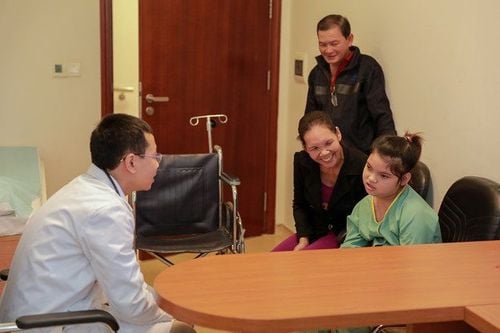
7. Follow-up and evaluation
After the stem cell transplant is discharged from the hospital, the child needs to be re-examined so that the treating doctor can evaluate and monitor the problems arising after the transplant: Pain, vomiting, fever, infection, fussiness... From there, the doctor will advise and adjust the treatment for the child to recover better.After 3 months, the child was examined for a second time, had a blood test to check blood counts, assessed liver and kidney function after stem cell transplant, and checked the child's initial response to stem cells.
After 6 months, 12 months, the child was re-examined to re-evaluate the child's disease status, change, and progress in the following areas: muscle tone, gross motor ability, fine motor ability, cognitive ability... after stem cell intervention.
Vinmec International General Hospital has applied stem cell method to successfully treat many cases of cerebral palsy that seemed hopeless. The whole process of stem cell transplantation for cerebral palsy at Vinmec is performed very closely, ensuring safety in accordance with international standards. All surgeries are performed by leading experts and doctors with modern machinery and medical equipment. In addition, Vinmec has also developed a standard transplant procedure so that it can share experiences with colleagues, creating more opportunities for treatment for children with cerebral palsy across the country.
Please dial HOTLINE for more information or register for an appointment HERE. Download MyVinmec app to make appointments faster and to manage your bookings easily.





